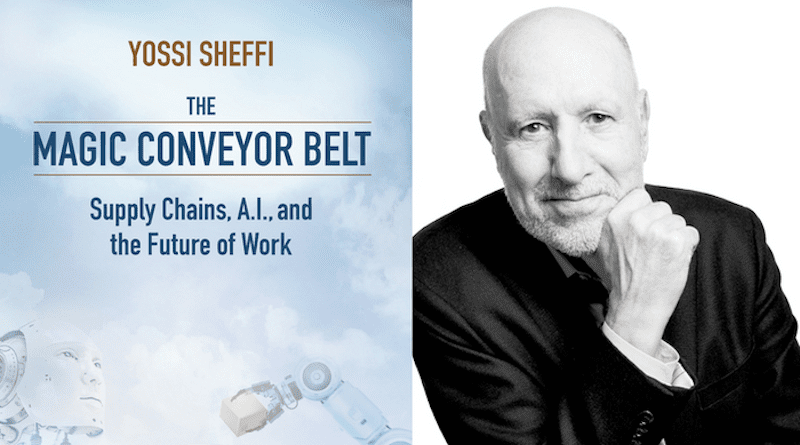Yossi Sheffi On AI And The Future Of The Supply Chain – Interview
By Peter Dizikes, MIT News Office
Global supply chains are immense feats of technological and organizational sophistication. They are also, as the onset of the Covid-19 pandemic showed, vulnerable to unexpected developments. Will that change as artificial intelligence becomes a bigger part of supply chains? And what will happen to workers in the process?
MIT Professor Yossi Sheffi explores these topics in a new book, “The Magic Conveyor Belt: AI, Supply Chains, and the Future of Work,” published by MIT’s CTL Media. Sheffi, the Elisha Gray II Professor of Engineering Systems at MIT, is also the director of MIT’s Center for Transportation and Logistics, which just marked its 50th anniversary. He talked with MIT News about the new book.
Q: Why did you write this book?
A: After the pandemic started, suddenly supply chains became hot. For the 50th anniversary of the Center for Transportation and Logistics in March, we thought about writing a paper, which became this book. In the first part of the book, I just explain how complex supply chains are, and how amazing they are. You should never be upset when something is not available in a supermarket or on Amazon; you should be amazed that something is there, once you understand what it takes to get it there. Supply chains underline not only people’s standard of living by ensuring the availability of medicines and everyday items, but they are crucial to responding to modern challenges such as resilience and sustainability. The book then examines the technology underlying supply chain operations and business in general, especially AI, leading to an exploration of future of work. These technologies are moving so fast it’s hard to know what will happen, of course.
Q: You can’t predict what impact AI will have, but how do you think about it, and discuss it in the book?
A: I looked at all the industrial revolutions; the fear of losing a job has always been prevalent. In 1589, William Lee asked the Queen of England for a patent for his stocking-making device. The queen shut it down, fearing job losses in the industry. When looms were automated in the 19th century, or when Ford started the production line for the Model T, this fear led to violence.
But with every technological change more jobs were created than lost. Every time, people said, “But now it’s different.” Even with AI, there’s a good chance more jobs will be created than lost. When ATMs came about, people thought there would be no more bank tellers. But the number of bank tellers in the U.S. has doubled. Why? Because opening a branch became a lot cheaper. When Ford made cars by hand, they had only a few hundred employees. With the Model T, there were 157,000, but this is not even the big story. When people could afford cars, people started driving everywhere, and motels and restaurants came up all around the U.S., millions of jobs were created. So you have growth in a profession itself and related areas.
There is little doubt that modern AI can increase productivity and unleash a new era of economic growth if it’s used for good. But I’d like to say one thing about why it may actually be somewhat different this time: the speed of change. Because unlike electricity or the steam engine, you don’t have to build huge plants. It’s software which, once developed, moves at the speed of light. Governments may have to prepare more for retraining and putting people in trade school faster. As AI becomes more sophisticated, it will develop a larger range of possibilities.
Q: Taking those insights, how might we see this being applied to to supply chains?
A: Supply chains are automating fast. Warehouses are full of robots. It’s the number one robotic application in China and many other places. A profession that used to be about driving trucks and moving boxes, as well as a male-dominant profession, is now increasingly a technical occupation, and we see a lot more women on the job.
But as of 2015, truck driving was still the number one profession in 29 U.S. states. Autonomous trucks are not going to drive into cities. To go there they would have to cross over white lines on roads, go over the sidewalks, and so on, which they are not programmed to do. Instead, the model for autonomous trucks is now what’s called exit-to-exit, where there would be transfer stations near highways and outside cities. A truck goes from the plant to the highway exit, then to the transfer facility to unload its goods. This is likely to create a lot of new jobs within the first mile and the last mile of an autonomous truck trip, and a lot of jobs at these stations, including retail, maintenance, and audit/check services. It may be hard to imagine, but I can see more jobs being created. I’m optimistic, but that’s my nature.
The reason I like to work in this area is that it’s a combination of things — technology and processes — but in the end, supply chains are human networks. Ultimately supply chain are made of people who make, store, move, contract, communicate — all augmented by increasingly powerful technologies. And technology is an augmenting force for many of the uniquely human qualities, not a replacement force.

